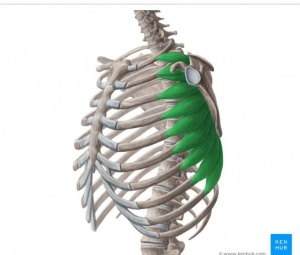Description
The serratus anterior muscle is a fan-shaped muscle at the lateral wall of the thorax.
Its main part lies deep under the scapula and the pectoral muscles.
It is easy to palpate between the pectoralis major and latissimus dorsi muscles.
Origin
It originates on the top surface of the eight or nine upper ribs. [1]
Insertion
It inserts exactly at the front border of the scapula, or shoulder blade.[1]
The muscle is divided into three parts :
- Upper / Superior : 1st to 2nd rib → superior angle of scapula.
- Middle / Intermedius : 2nd to 3rd rib → medial border of scapula.
- Lower / Inferior : 4th to 9th rib → medial border and inferior angle of scapula.
It is the most powerful and prominent part.[2]
Nerve
The long thoracic nerve ( C5_7) supplies the serratus anterior muscle.
Function
The function of the serratus anterior muscle is to allow the forward rotation of the arm and to pull the scapula forward and around the rib cage. The scapula is able to move laterally due to the serratus anterior muscle, which is vital for the elevation of the arm. The serratus anterior muscle also allows the upward rotation of the arm, which allows a person to lift items over their head.[1]
When the shoulder blade is in fixed position , e.g : breathing after a sprint , the serratus anterior lifts the ribcage and thus supports breathing.[2]
Video
Clinical relevance
long thoracic nerve is highly affected during surgery of the anterolateral thorax , for example, during axillary dissection or radical mastectomy , and this can lead to injury this nerve and resuit of injury of serratus anterior muscle .
Typical symptoms for this injury are scapular winging and loss of ability to raise the affected arm overhead.
Also lead to chronic denervation of the serratus anterior muscle, prominent continuous muscle contraction, with accumulation of toxic metabolites, and pain pathways causing central sensitization.
In addition, the serratus anterior muscle is at risk of injury if it is dissected together with the pectoralis muscles to make the pocket needed for breast expanders.
Another causes for injury of long thoracic nerve are trauma and a compression due to carrying heavy loads (e.g. backpack) and trauma.
Assessment
Palpation
The serratus anterior muscle is very thin and covers the side of the ribcage.
- You can feel it by putting your hand just below the arm pit.
- It also helps to experience how your ribs feel, so that you can distinguish the ribs and this thin and superficial muscle.
- To do so, just feel the first ribs under your nipple.
- Now you will be able to distinguish the muscle from the ribs.
Serratus Anterior Muscle Pain Syndrome (SAMPS) And Trigger Points
Chronic chest pain of noncardiac origin is a heterogeneous disorder, and myofascial pain syndrome is often an overlooked cause that can affect a single muscle or several functional muscle units; it is characterized by taut bands, commonly described as trigger points.
The syndrome includes a constellation of symptoms one of which is pain overlying the fifth to seventh ribs in the midaxillary line.
Referred pain may radiate toward the anterior chest wall, the medial aspect of the arm, and finally, toward the ring and little finger on the ipsilateral side .
The pain of SAMPS can be intermittent or constant.
The serratus mainly contributes to :
- Pain between shoulder blades
- . Golfers elbow pain
- Rib pain
- Arm pain[3]
Differential Diagnosis
Intercostal Nerve Neuralgia
It can be differentiated through palpation.
In SAMPS , palpation of trigger points will produce the pain that occurs spontaneously.
In intercostal neuralgia , palpation will not produce pain or referred pain because the pain of intercostal neuralgia is situated along a dermatome.
Video
References
- ↑ 1.01.11.2 ↑ 2.02.1 M. Schünke/E. Schulte/U. Schumacher: Prometheus – LernAtlas der Anatomie – Allgemeine Anatomie und Bewegungssystem, 2.Auflage, Thieme Verlag (2007), S.294-295
J. E. Muscolino: The muscular system manual – The skeletal muscles of the human body, 2.Auflage, Elsevier Mosby (2005), S.214-217
P. Berlit: Klinische Neurologie, 3.Auflage, Springer Verlag (2011), S.345↑ Calais-German, Blandine. Anatomy of Movement. Seattle: Eastland Press, 1993. Print
Davies, Clair, and Davies, Amber. The Trigger Point Workbook: Your Self-Treatment Guide For Pain Relief. Oakland: New Harbinger Publications, Inc., Print
Simons, David G., Lois S. Simons, and Janet G. Travell. Travell & Simons’ Myofascial Pain and Dysfunction: The Trigger Point Manual. Baltimore, MD: Williams & Wilkins, 1999. Print.
Schünke, Michael., Schulte, Erik, and Schumacher, Udo. Prometheus: Lernatlas der Anatomie. Stuttgart/New York: Georg Thieme Verlag, 2007. Print

